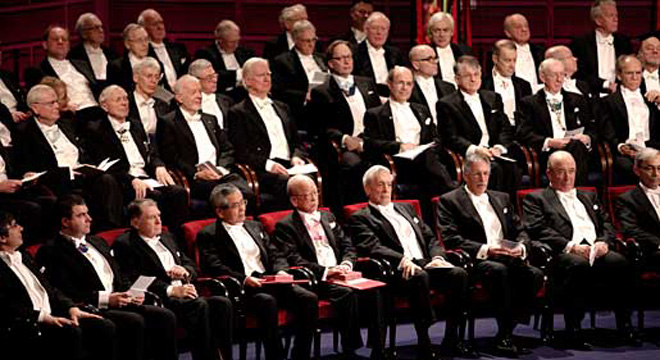CHRISTINE HOEKENGA
Let’s hear it for the late bloomers: According to a new study, scientific breakthroughs–the kind that garner Nobel prizes–increasingly come to scientists who are 45 and older.
Researchers from Ohio State University and Northwestern University examined the age at which Nobel laureates did their prize-winning work for awards in physics, chemistry, and medicine between 1901 and 2008.
Their study, published on Monday in the early online edition of the journal the Proceedings of the National Academies of Science, shows that the mean age of scientists making Nobel-winning discoveries has crept up over time.
The trend was most pronounced in Einstein’s own field of physics, where the average age shifted from 36.9 early in the century to 50.3 in recent decades. In chemistry, the mean shifted from 36.1 to 46.3 and in medicine from 37.6 to 45.0.
“There’s this iconic image of the young genius doing breakthrough work,” said Bruce Weinberg, co-author of the study and professor of economics at Ohio State University. “But that’s not the universal pattern, especially today.”
So what’s causing the shift? Weinberg and his co-author, Benjamin Jones of Northwestern University, suggest two likely factors: changes in scientific training norms and changes to the foundational knowledge within scientific disciplines.
In Einstein’s day, many scientists, including the bulk of Nobel laureates, received their highest degree (usually a PhD) by the age of 25. In all three fields that proportion has declined over time, meaning that many eventual Nobel winners are starting their careers later. As knowledge accumulates, scientists may need longer to master the fundamentals and ultimately to make a substantial new contribution to a field, according to Weinberg.
But the reverse effect–when a discipline undergoes a radical change in thinking and new theoretical work renders prior knowledge obsolete–can also impact demographics in a big way.
The researchers point to physics as an example. During the early 20th century, young scientists like Werner Heisenberg transformed physics through the development of quantum mechanics. Heisenberg published his prize-winning work at the age of 23, and he wasn’t alone. Into the 1930’s a sizable proportion of physics Nobel Laureates did their breakthrough work by the age of 30 (peaking at 31 percent in 1923) or 40 (peaking at 78 percent in 1934).
“Classical physics was just less relevant at that time, and people didn’t have to learn it to succeed.” Weinberg says. “In fact, it may have actually hindered people from thinking abstractly and making theoretical breakthroughs. A certain amount of ignorance may actually have been helpful.”
This heyday of theoretical work among young physicists helps explain the larger demographic shift in physics over the century, but the impact of abstract work can also be seen in chemistry and medicine. Across all three fields, Nobel laureates whose work contained a substantial theoretical component made their breakthroughs an average of about four and a half years earlier than their counterparts doing experimental work.
These findings are mixed news for science as a whole. While the study may calm some misgivings about our aging scientific workforce, it still hints at a problem.
“The research suggests that it takes longer and longer to master all the material needed to make it to the scientific frontier.” Weinberg says. “If that’s the case, it may mean that scientific progress could slow down.”
For the young, ambitious scientist trying to live up to the iconic image of genius, Weinberg offers this advice: “It’s possible, in principle, to do great work early in a career, but I would tell young scientists to be patient and keep going, even if they haven’t had a breakthrough yet.”









